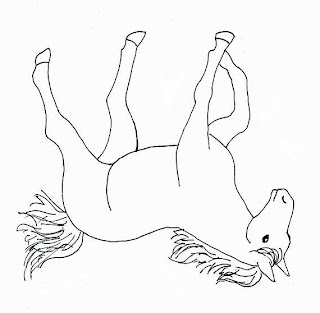 |
| Blind contour drawing by Maddie |
Fourth graders were asked to draw an outline of a horse. To get the outline of the animal drawn accurately, we tried out a couple of fun artist tricks. Can you tell that Maddie's drawing is a horse? Not only can we see the animal, but it looks like it is full of movement!
 |
| Blind Contour drawing by Nico |
 |
| Blind Contour drawing by Mason |
Another strange exercise we tried was to draw our horses upside down. Why would an artist want to draw upside down? I did not suggest that we stand on our heads . . . but to draw an image that is turned around. It is a challenge to see all the fine details of an image correctly. Drawing this way can trick your eyes into observing more of the details of the picture.
 When you look at a picture of a horse the regular way, your mind invariably takes over as you are drawing and you tend to draw what you remember how a horse looks, not as shown in the picture in front of you. The image of the horse in your mind probably has an four thin legs as all horses do. But are you really seeing those legs as they appear in the picture, with all the angles and the lines?
When you look at a picture of a horse the regular way, your mind invariably takes over as you are drawing and you tend to draw what you remember how a horse looks, not as shown in the picture in front of you. The image of the horse in your mind probably has an four thin legs as all horses do. But are you really seeing those legs as they appear in the picture, with all the angles and the lines?Now look at this upside down picture of a horse. By turning the image around, we transform the horse into a random picture filled with angles and shapes. It is much easier to notice how to draw the legs this way. Even the negative space in between the legs is easier to see and helps us place the legs in the right position and with the correct angles.
These exercises were challenging for us to do. The more we trick our minds into seeing the world in a different way, the more we can observe the world through the eyes of an artist.
No comments:
Post a Comment
Thank you for your thoughts!
Barbara Levine
Ranney Lower School Art